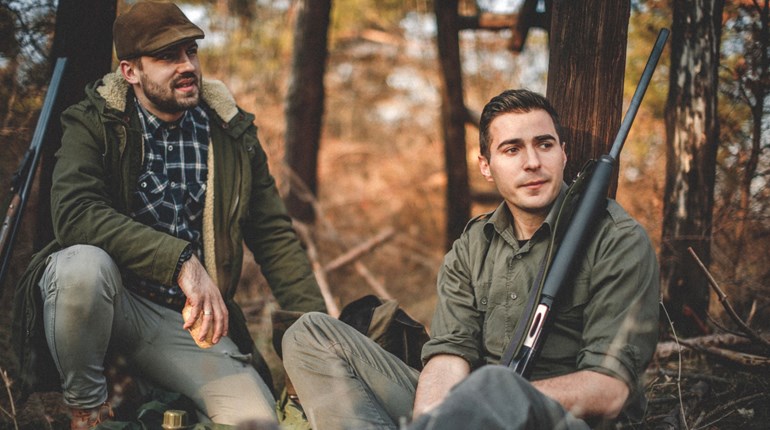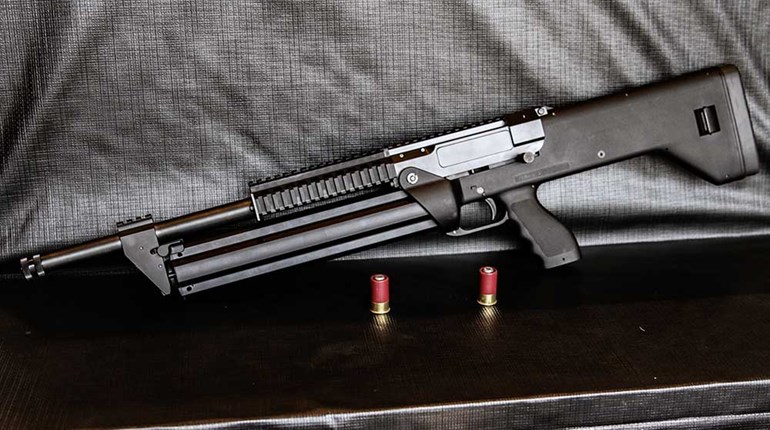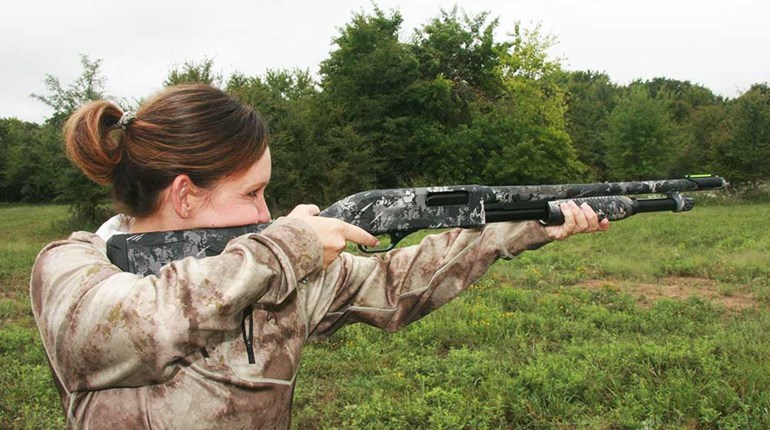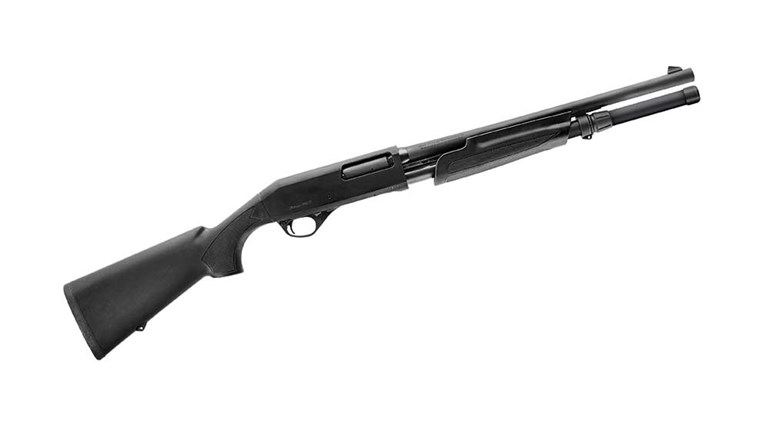
The alfalfa field was planted on a plateau above a looping bend in the river that effectively shielded it from prospective road riflemen. What little noise my Bad Boy’s tires made over the sandy two-track was suppressed by a foreboding December wind, but honestly I don’t think it would’ve mattered. Fifteen minutes after I’d climbed into my treestand, a doe and a yearling entered this green island of sustenance to fortify themselves against a winter that was as predictable as a biker brawl in the streets of Sturgis. If they saw me climb my stand, they didn’t care. A storm was imminent, likely the big one of the year, and the barometer was ticking away like a time bomb.
Forty-five minutes later, my field of view was impaired by whitetails. There were six bucks and 16 does feeding 125 yards in front of me, and more piling into the field from all hands of the clock. One of the bucks was a tall 10-pointer, and I studied hard on flicking the safety of the Savage 6.5x284 in my hands and busting up this feeding-lot party.
Should I shoot him? How big is he? Is he mature? What are the odds of seeing a Booner? What’ll I do if I tag out early? What’s the weather doing tomorrow? I’ll readily admit that these questions are miniscule in the overall scheme of life, but at the time they were important to me, and so I wrestled with them as I so often do.
Sure, it was the first day of my hunt—and normally if I have to question whether I should shoot a deer I’m better off not shooting him at all—but my questions all checked out. How big was he? Bigger than the others. He had 10 points and a big Bergmann’s Rule body, so I was guessing him in the mid-140s. Would I see a B&C-caliber buck? Sure, Jeff, and you’ll win the lotto and marry a model. What would I do tomorrow if I shoot? The doe tag in my pocket would keep me in camo rather than in pajamas. What was the weather supposed to do? Probably turn icy and miserable.
Suddenly, the buck began to appear larger. Then, some strange force began sliding the Savage’s barrel out onto the treestand’s rest as my trigger finger found its place. Lucky for me I wasn’t overly fast on the pull, because just then another buck trotted into the field.
Please excuse this little tangent, but back in my small-town high school’s woodshop class, I had an old, country teacher named Mr. Truitt. Mr. Truitt was an outdoorsman, a front-porch philosopher. He was a Woodie Guthrie-like throwback who was chock-full of country wit and truthful sayings that generations of students came to know as “Truittisms.” One day, when I asked if he thought the treestand I was welding was too large he said, rather cryptically: “A 10-pound robin is fat … but not if it’s sitting by a 20-pound robin.” Now, finally, I understood.
You know all that stuff I wrote about my questions checking out? Scratch that. The deer I was about to take was the biggest in the field … until a bigger one showed up. Don’t get me wrong—neither were the biggest deer I’d ever seen, but my guide had already told me what to expect. Mike Stroff III said I’d better be shooting mid-140 deer, and I believed him, because he was a retired Marine. Were there bigger? Maybe. Would I be happy with this one? Yes. Besides, I was shooting a new rifle, and—call me inquiring—I wanted to see what it would do.
As the buck turned to walk away, I had that feeling that I’d regret it if I let him go—you know, the old “you don’t know what you’ve got till it’s gone” cliché. Here’s news: Clichés are clichés because they’re frequently right. While it’s also true that you can’t take a Boone and Crockett buck if you shoot a smaller one first, you must temper this truism with a dose of reality. Reality was, the buck before me was nice, as confirmed by my quivering hands and short breaths. So I flicked the safety off the 6.5 and laid my face on its raised cheekpiece. But when I did, the buck put on a surprising burst of speed and bounded out of my scope, into the river bottom and out of my life.
I was crushed with disappointment and letdown … for nearly half a second. Then I soon found the reason for his sudden motivation. Yet another, bigger buck had arrived from the drab unknown. Although I’ve never been the sharpest saw in shop class, I needn’t have begun a journey of deductive reasoning to immediately conclude the following: If I decide to shoot a buck, and then a bigger one shows up, I’m shooting the bigger one instead. It’s simple logic, really, and so I again leveled the rifle.
■■■
Meanwhile, about 20 miles away in a cottonwood draw, inverse thoughts were coursing Eddie Breland’s mind. Breland, whom I’d met only the night before when we’d arrived in camp, owns Breland Machinery of southwest Alabama, and this hunt was his reward for a solid year of business. On his first day in a stand, the bowhunter glimpsed a 160-class buck cruise through the woods just out of range. He saw approximately 30 bucks that evening and in the subsequent few days of hunting, but each one did not even arouse a twitch of desire in this deer hunter’s soul as they passed him, broadside, as if begging to be taken.
Ah, if Mr. Truitt could put this phenomenon into an adage, it might go like this: An XLT with low miles is nice … until the dealer shows you a sparkling new King Ranch dually 4x4 with leather and a winch. Was Eddie being greedy? I think not; it’s human nature. But Eddie Breland from Alabama was also getting mighty cold.
■■■
By now, you’re probably thinking that I’m taking a great liberty in referring to this as a “deer hunt” rather than a deer shoot. Well, that’s precisely the point of this story. South Dakota’s river-bottom deer hunting can be as fruitful as South Texas in terms of sheer whitetail numbers. Both are terrific whitetail havens, but SD does so without the artificiality of corn feeders and box blinds—genius adaptations that meld luxury and effectiveness that Texans have found do a great job of mitigating the sting of the wind and ensuring bucks will show up 30 minutes before dusk. Whether in Texas, South Dakota or Saskatchewan, it’s all about realizing where you’re hunting, managing expectations and being happy with the outcome, whatever it may be.
But before you simply write me off as merely lucky or fortunate (I won’t deny either), please realize that while I did little but climb into a stand in South Dakota, these deer didn’t appear before me as if they were shot from a magic deer cannon. A skilled outfitter—in this case outdoor TV personality and owner/operator of Western Ranch Outfitters Mike Stroff—carefully selected the location, worked with landowners to cultivate the field, placed the stand and kept it pristine until a client could hunt it. I happened to be that client. That’s how outfitters earn their living. To them, luck doesn’t have much to do with it. It’s all about odds.
The key to Stroff’s late-winter success is acreage and food. He spends decent dollars leasing nearly 70,000 acres of prime southwestern South Dakota riverine habitat, copious hours each year working with local farmers—i.e., convincing them not to cut their crops immediately—and countless hours glassing deer, contemplating strategy and placing stands. In fact, Stroff outfits a ranch in South Texas, and he likes SD better in terms of deer numbers and diverse terrain that allows various hunting methods. If you don’t want to sit in a stand overlooking an alfalfa field all day—likely your best odds—spot-and-stalk is an option. Yes, Mr. Truitt might say that South Dakota hunting is easy … if someone else puts in all the hard work.
■■■
Three days later it was 18 degrees below zero. A sheen of ice glazed inches of fresh snow, and the wind was colder than a sustained blast from a can of Freon. Eddie, not knowing if he could draw his bow under an eight-layer cake of clothes, decided to go for something between the XLT and the King Ranch—maybe a Lariat with an enhanced trim package. He pulled into camp with a great buck—one that immediately made my “140s buck” look more like the high 130s it actually was—on the back of the electric hunting vehicle. It was difficult to determine Eddie’s demeanor because his chin and mouth were nearly frozen into a permanent expression of “brrrrrr.”
“A buck in the Bad Boy is better than one in the river bottom,” I mumbled dumbly, as I helped him winch it into the skinning shed where my buck and doe hung stiffly. If he was disappointed that it’s wasn’t the 160-inch deer of his desire, he didn’t show it. Reality was, all of our deer scored very high up in the great steak record books and contended for top honors in the world’s fun factor index.
That afternoon, as Eddie and I left camp to fly back home to our jobs and awaiting work, another Truittism entered my mind: For as much as that wise woodshop teacher liked showing up each morning to work and impart kids with wisdom … I’d bet he liked his days off better. Indeed, the coldest day hunting is better than … well, you know the rest.






































